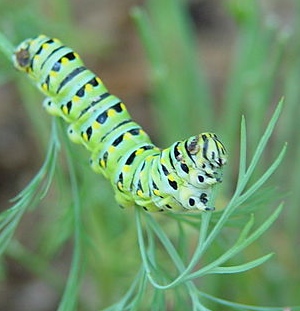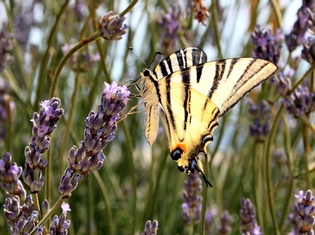This is our second in a series of articles on edible butterfly gardens. This article will share with you a number of edible herbs that will attract swallowtail butterflies to your garden but also provide you with some tasty treats as well.
As I mentioned in our earlier article on edible butterfly gardens and herb gardens for Monarch butterflies, to attract and keep butterflies in your garden, you will need both nectar and host plants. Nectar plants provide food for adult butterflies and host plants provide food for butterfly larvae and a place for butterflies to lay their eggs.
Swallowtail Butterfly Host Plants
 It seems that almost all butterflies enjoy dill and fennel; as both a nectar source and a host plant. But, the pair of aromatic herbs are particularly favored by black swallowtails. There are a number of companion plants for dill but pretty much the only companion plant for fennel is dill. Since they have similar growth patterns, are highly attractive to swallowtail butterflies and are quite tasty for us too; why not plant a patch of them together and attract beauties like this anise swallowtail caterpillar to your herb garden for swallowtails?
It seems that almost all butterflies enjoy dill and fennel; as both a nectar source and a host plant. But, the pair of aromatic herbs are particularly favored by black swallowtails. There are a number of companion plants for dill but pretty much the only companion plant for fennel is dill. Since they have similar growth patterns, are highly attractive to swallowtail butterflies and are quite tasty for us too; why not plant a patch of them together and attract beauties like this anise swallowtail caterpillar to your herb garden for swallowtails?
Thyme for Swallowtail Butterflies
Growing thyme and letting it flower will attract a number of butterflies and honeybees to your garden but they are a particular favorite nectar source for black swallowtails.
Mint
A number of swallowtail butterfly species use mint as a nectar source including: the western tiger swallowtail, the anise swallowtail and pale swallowtail. Mints are also a favorite of white peacock, painted ladies, red admiral, west coast lady and gray hairstreak butterflies.
Joe Pye Weed
Joe Pye Weed is a herbaceous plant but not one that most consider edible. It has been used by Native Americans and others for medicinal purposes but it is typically only planted today for their scent and flowers. I’ve included it in this list anyway because so many of the swallowtail butterflies seem to favor it as a nectar source. The list includes: anise swallowtail, black swallowtail, giant swallowtail, spicebush swallowtail, tiger swallowtail and zebra swallowtail.
Lavender
 Lavender did not appear in my research as being a particular favorite of swallowtail butterflies. It is a wonderful nectar source for honeybees and all butterflies which puts it high on any list of herbs for butterfly gardens. I’ve included it here primarily because I couldn’t resist including this stunning photograph of a scarce swallowtail butterfly feeding on lavender blooms (It is the work of Stella Vješnica). They are not native to North Carolina or even the United States but any European visitors to Our Herb Garden may find one of these lovelies visiting their own butterfly gardens.
Lavender did not appear in my research as being a particular favorite of swallowtail butterflies. It is a wonderful nectar source for honeybees and all butterflies which puts it high on any list of herbs for butterfly gardens. I’ve included it here primarily because I couldn’t resist including this stunning photograph of a scarce swallowtail butterfly feeding on lavender blooms (It is the work of Stella Vješnica). They are not native to North Carolina or even the United States but any European visitors to Our Herb Garden may find one of these lovelies visiting their own butterfly gardens.
Once you have planted your edible herb garden for swallowtails and other butterflies, you will hopefully find yourself meeting all sorts of new winged friends. The Kaufman Field Guide to Butterflies of North America is our family’s choice for identifying butterflies that visit our garden. It includes a handy way to quickly zero in on the species and provides information on their territories, distinctive characteristics and larval foodplants.
I found your website on Google images. I have many swallowtail caterpillars on my parsley plants and wanted more information about them.
While parsley wasn’t among the plants my research said was great for attracting swallowtails, Katherine’s experience would indicate it is. And, come to think of it, years ago, we had a little plant of parsley from and end of season sale that was almost immediately nibbled to extinction by marauding caterpillars.